Social Evaluation of Public Open Space Services and Their Impact on Well-Being: A Micro-Scale Assessment from a Coastal University
Abstract
:1. Introduction
2. Materials and Methods
2.1. Study Area
2.2. Identification of the Functions of POS
2.3. Questionnaire Design and Collection of Data
2.4. Evaluation of the Perceived Importance of POSS
2.5. Statistical Analysis
3. Results
3.1. Characteristics of the Respondents and POS Preferences
3.2. Impact of Socio-Demographic Attributes on the Evaluation of POSS
3.3. Impact of POSS on Well-Being
3.4. Stakeholders Perception of POS Attributes and Management
3.5. Factor Analysis and Segmentation of POSS
4. Discussion
Limitations and Future Directions of the Research
5. Conclusions
- More than 70% of stakeholders were aware of the services provided by POS within the university campus.
- Among the services provided by POS, the highest preference was given to educational value (4.71) followed by sense of place (4.70), spiritual value (4.69), inspiration (4.65), social cohesion (4.61), leisure (4.52), and living area (4.50).
- The importance of POSS is largely determined by the socio-demographic attributes of the stakeholders (gender, age, educational level). It was found that males give more importance to POSS than females. Bachelor’s students gave a relatively high value to POSS in comparison to Ph.D. students, diploma students, high school students, and master’s students.
- There were significant differences in the perceived importance of POSS by gender, age, and social group, showing the significant impact of socio-demographic attributes on the perceived importance of POSS.
- About 70 to 90% of the total stakeholders reported that POSS have a positive impact on well-being (ranging from little to extremely) such as maintenance of body weight, enhancement of activeness, maintenance of hypertension, reduction of mental stress, and enhancement of energy levels.
- It was observed that about 80 to 90% of stakeholders are satisfied (ranging from agree to strongly agree) with the management of POS within the university campus.
- The factor analysis showed that there were seven POSS (walking, recreational, physical fitness, public participation, living area) falling under principal component 1 (46% of the total POSS).
Author Contributions
Funding
Institutional Review Board Statement
Informed Consent Statement
Data Availability Statement
Conflicts of Interest
References
- Zhu, B.-W.; Zhang, J.-R.; Tzeng, G.-H.; Huang, S.-L.; Xiong, L. Public Open Space Development for Elderly People by Using the DANP-V Model to Establish Continuous Improvement Strategies towards a Sustainable and Healthy Aging Society. Sustainability 2017, 9, 420. [Google Scholar] [CrossRef] [Green Version]
- Hecke, L.V.; Ghekiere, A.; Veitch, J.; Dyck, D.V.; Cauwenberg, J.V.; Clarys, P.; Deforche, B. Public open space characteristics influencing adolescents’ use and physical activity: A systematic literature review of qualitative and quantitative studies. Health Place 2018, 51, 158–173. [Google Scholar] [CrossRef] [PubMed]
- Koohsari, M.J.; Badland, H.; Mavoa, S.; Villanueva, K.; Francis, J.; Hooper, P.; Owen, N.; Giles-Corti, B. Are public open space attributes associated with walking and depression? Cities 2018, 74, 119–125. [Google Scholar] [CrossRef]
- Carmona, M. Principles for public space design, planning to do better. Urban Des. Int. 2019, 24, 47–59. [Google Scholar] [CrossRef] [Green Version]
- Koohsari, M.J.; Mavoa, S.; Villanueva, K.; Sugiyama, T.; Badland, H.; Kaczynski, A.T.; Owen, N.; Giles-Corti, B. Public open space, physical activity, urban design and public health: Concepts, methods and research agenda. Health Place 2015, 33, 75–82. [Google Scholar] [CrossRef] [Green Version]
- Florindo, A.A.; Barrozo, L.V.; Cabral-Miranda, W.; Rodrigues, E.Q.; Turrell, G.; Goldbaum, M.; Cesar, C.L.G.; Giles-Corti, B. Public Open Spaces and Leisure-Time Walking in Brazilian Adults. Int. J. Environ. Res. Public Health 2017, 14, 553. [Google Scholar] [CrossRef] [Green Version]
- Yung, E.H.K.; Conejos, S.; Chan, E.H.W. Social needs of the elderly and active aging in public open spaces in urban renewal. Cities 2016, 52, 114–122. [Google Scholar] [CrossRef]
- Villanueva, K.; Badland, H.; Hooper, P.; Koohsari, M.J.; Mavoa, S.; Davern, M.; Roberts, R.; Goldfeld, S.; Giles-Corti, B. Developing indicators of public open space to promote health and wellbeing in communities. Appl. Geogr. 2015, 57, 112–119. [Google Scholar] [CrossRef]
- Pretty, B.; Pretty, J. What is the Best Dose of Nature and Green Exercise for Improving Mental Health? A Multi-Study Analysis. Environ. Sci. Technol. 2010, 44, 3947–3955. [Google Scholar] [CrossRef]
- Mackay, G.J.; Neill, J.T. The effect of “green exercise” on state anxiety and the role of exercise duration, intensity, and greenness: A quasi-experimental study. Psychol. Sport Exerc. 2011, 11, 238–245. [Google Scholar] [CrossRef]
- Groenewegen, P.P.; Berg, A.E.v.d.; Maas, J.; Verheij, R.A.; Vries, S.D. Is a Green Residential Environment Better for Health? If So, Why? Ann. Assoc. Am. Geogr. 2012, 102, 996–1003. [Google Scholar] [CrossRef]
- Pretty, J.; Barton, J.; Bharucha, Z.P.; Bragg, R.; Pencheon, D.; Wood, C.; Depledge, M.H. Improving health and well-being independently of GDP: Dividends of greener and prosocial economies. Int. J. Environ. Health Res. 2016, 26, 11–36. [Google Scholar] [CrossRef] [Green Version]
- Pretty, J.N. Manifesto for the Green Mind. Resurgence Ecol. 2017, 301, 18–21. [Google Scholar]
- Sugiyama, T.; Francis, J.; Middleton, N.J.; Owen, N.; Giles-Corti, B. Associations Between Recreational Walking and Attractiveness, Size, and Proximity of Neighborhood Open Spaces. Am. J. Public Health 2010, 100, 1752–1757. [Google Scholar] [CrossRef]
- Bancroft, C.; Joshi, S.; Rundle, A.; Hutson, M.; Chong, C.; Weiss, C.C.; Genkinger, J.; Neckerman, K.; Scopus, V.I.; Lovasi, G. Association of proximity and density of parks and objectively measured physical activity in the United States: A systematic review. Soc. Sci. Med. 2015, 138, 22–30. [Google Scholar] [CrossRef] [PubMed]
- Nath, T.K.; Han, S.S.Z.; Lechner, A.M. Urban green space and well-being in Kuala Lumpur, Malaysia. Urban For. Urban Green. 2018, 36, 34–41. [Google Scholar] [CrossRef]
- Jennings, V.; Bamkole, O. The Relationship between Social Cohesion and Urban Green Space: An Avenue for Health Promotion. Int. J. Environ. Res. Public Health 2019, 16, 452. [Google Scholar] [CrossRef] [PubMed] [Green Version]
- Jackson, L.E.; Daniel, J.; McCorkle, B.; Sears, A.; Bush, K.F. Linking ecosystem services and human health: The Eco-Health Relationship Browser. Int. J. Public Health 2013, 58, 747–755. [Google Scholar] [CrossRef]
- Braubach, M.; Egorov, A.; Mudu, P.; Wolf, T.; Thompson, C.W.; Martuzzi, M. Effects of Urban Green Space on Environmental Health, Equity and Resilience. In Nature-Based Solutions to Climate Change Adaptation in Urban Areas; Kabisch, N., Korn, H., Stadler, J., Bonn, A., Eds.; Springer: Cham, Switzerland, 2017; pp. 187–205. [Google Scholar] [CrossRef] [Green Version]
- Wood, L.; Hooper, P.; Foster, S.; Bull, F. Public green spaces and positive mental health—investigating the relationship between access, quantity and types of parks and mental wellbeing. Health Place 2017, 48, 63–71. [Google Scholar] [CrossRef]
- Subramanian, D.; Jana, A. Assessing urban recreational open spaces for the elderly: A case of three Indian cities. Urban For. Urban Green. 2018, 35, 115–128. [Google Scholar] [CrossRef]
- Nasution, A.D.; Zahrah, W. Quality of Life: Public open space effects. Asian J. Environ. Behav. Stud. 2018, 3. [Google Scholar] [CrossRef]
- Bogdanović Protić, I.; Mitković, P.; Vasilevska, L. Toward Regeneration of Public Open Spaces within Large Housing Estates–A Case Study of Niš, Serbia. Sustainability 2020, 12, 256. [Google Scholar] [CrossRef]
- Edwards, N.; Hooper, P.; Trapp, G.S.A.; Bull, F.; Boruff, B.; Giles-Corti, B. Development of a Public Open Space Desktop Auditing Tool (POSDAT): A remote sensing approach. Appl. Geogr. 2013, 38, 22–30. [Google Scholar] [CrossRef]
- Labib, S.M.; Lindley, S.; Huck, J.J. Spatial dimensions of the influence of urban green-blue spaces on human health: A systematic review. Environ. Res. 2020, 180, 108869. [Google Scholar] [CrossRef]
- Lamb, K.E.; Mavoa, S.; Coffee, N.T.; Parker, K.; Richardson, E.A.; Thornton, L.E. Public open space exposure measures in Australian health research: A critical review of the literature. Geogr. Res. 2019, 57, 67–83. [Google Scholar] [CrossRef] [Green Version]
- Wolch, J.R.; Byrne, J.; Newell, J.P. Urban green space, public health, and environmental justice: The challenge of making cities ‘just green enough’. Landsc. Urban Plan. 2014, 125, 234–244. [Google Scholar] [CrossRef] [Green Version]
- Addas, A.; Maghrabi, A. A Proposed Planning Concept for Public Open Space Provision in Saudi Arabia: A Study of Three Saudi Cities. Int. J. Environ. Res. Public Health 2020, 17, 5970. [Google Scholar] [CrossRef]
- Addas, A. Enhanced Public Open Spaces Planning in Saudi Arabia to Meet National Transformation Program Goals. Curr. Urban Stud. 2020, 8, 184–204. [Google Scholar] [CrossRef]
- Addas, A.; Alserayhi, G. Quantitative Evaluation of Public Open Space per Inhabitant in the Kingdom of Saudi Arabia: A Case Study of the City of Jeddah. SAGE Open 2020, 10, 1–18. [Google Scholar] [CrossRef]
- Addas, A.; Rishbeth, C. The transnational Gulf City: Saudi and migrant values of public open spaces in Jeddah. Landsc. Res. 2018, 43, 939–951. [Google Scholar] [CrossRef]
- Mandeli, K. Public space and the challenge of urban transformation in cities of emerging economies: Jeddah case study. Cities 2019, 95, 102409. [Google Scholar] [CrossRef]
- Mandeli, K.N. Public Spaces in A Contemporary Urban Environment: Multi-Dimensional Urban Design Approach for Saudi Cities. Ph.D. Thesis, University of Newcastle, Tyne, UK, 22 October 2011. [Google Scholar]
- Mandeli, K.N. Promoting public space governance in Jeddah, Saudi Arabia. Cities 2010, 27, 443–455. [Google Scholar] [CrossRef]
- Novoa, A.; Dehnen-Schmutz, K.; Fried, J.; Vimercati, G. Does public awareness increase support for invasive species management? Promising evidence across taxa and landscape types. Biol. Invasions 2017, 19, 3691–3705. [Google Scholar] [CrossRef]
- Addas, A. Motivation and Attachment in the Use of Public Open Spaces in Jeddah, Saudi Arabia. Ph.D. Thesis, The University of Sheffield, Sheffield, UK, 30 March 2015. [Google Scholar]
- Carr, S.; Francis, M.; Rivlin, L.G.; Stone, A.M. Public Space, 1st ed.; Cambridge University Press: Cambridge, UK, 1993; p. 420. [Google Scholar]
- Stanley, B.W.; Stark, B.L.; Johnston, K.L.; Smith, M.E. Urban Open Spaces in Historical Perspective: A Transdisciplinary Typology and Analysis. Urban Geogr. 2013, 33, 1089–1117. [Google Scholar] [CrossRef] [Green Version]
- Yamane, T. Statistics: An Introductory Analysis; Harper and Row: New York, NY, USA, 1967. [Google Scholar]
- Laterra, P.; Orúe, M.E.; Booman, G.C. Spatial complexity and ecosystem services in rural landscapes. Agric. Ecosyst. Environ. 2012, 154, 56–67. [Google Scholar] [CrossRef]
- García-Nieto, A.P.; García-Llorente, M.; Iniesta-Arandia, I.; Martín-López, B. Mapping forest ecosystem services: From providing units to beneficiaries. Ecosyst. Serv. 2013, 4, 126–138. [Google Scholar] [CrossRef]
- Clec’h, S.L.; Oszwald, J.; Decaens, T.; Desjardins, T.; Dufour, S.; Grimaldi, M.; Jegou, N.; Lavelle, P. Mapping multiple ecosystem services indicators: Toward an objective-oriented approach. Ecol. Indic. 2016, 69, 508–521. [Google Scholar] [CrossRef]
- Faed, A.; Chang, E.; Saberi, M.; Hussain, O.K.; Azadeh, A. Intelligent customer complaint handling utilising principal component and data envelopment analysis (PDA). Appl. Soft Comput. 2016, 47, 614–630. [Google Scholar] [CrossRef]
- Merga, H.; Fufa, T. Impacts of working environment and benefits packages on the health professionals’ job satisfaction in selected public health facilities in eastern Ethiopia: Using principal component analysis. BMC Health Serv. Res. 2019, 19, 494. [Google Scholar] [CrossRef] [PubMed] [Green Version]
- Jackson, E.F.; Siddiqui, A.; Gutierrez, H.; Kante, A.M.; Austin, J.; Phillips, J.F. Estimation of indices of health service readiness with a principal component analysis of the Tanzania Service Provision Assessment Survey. BMC Health Serv. Res. 2015, 15, 536. [Google Scholar] [CrossRef] [Green Version]
- Friesen, C.E.; Seliske, P.; Papadopoulos, A. Using Principal Component Analysis to Identify Priority Neighbourhoods for Health Services Delivery by Ranking Socioeconomic Status. Online J. Public Health Inform. 2016, 8, e192. [Google Scholar] [CrossRef] [PubMed] [Green Version]
- Mashal, N.; Kasirer, A. Principal component analysis study of visual and verbal metaphoric comprehension in children with autism and learning disabilities. Res. Dev. Disabil. 2012, 33, 274–282. [Google Scholar] [CrossRef] [PubMed]
- Natalia, P.; Clara, R.A.; Simon, D.; Noelia, G.; Barbara, A. Critical elements in accessible tourism for destination competitiveness and comparison: Principal component analysis from Oceania and South America. Tour. Manag. 2019, 75, 169–185. [Google Scholar] [CrossRef]
- Jorgensen, A.; Anthopoulou, A. Enjoyment and fear in urban woodlands—Does age make a difference? Urban For. Urban Green. 2007, 6, 267–278. [Google Scholar] [CrossRef]
- Sanesi, G.; Chiarello, F. Residents and urban green spaces: The case of Bari. Urban For. Urban Green. 2006, 4, 125–134. [Google Scholar] [CrossRef]
- Jim, C.Y.; Shan, X. Socioeconomic effect on perception of urban green spaces in Guangzhou, China. Cities 2013, 31, 123–131. [Google Scholar] [CrossRef]
- Jennings, V.; Larson, L.; Yun, J. Advancing Sustainability through Urban Green Space: Cultural Ecosystem Services, Equity, and Social Determinants of Health. Int. J. Environ. Res. Public Health 2016, 13, 196. [Google Scholar] [CrossRef] [Green Version]
- Ward Thompson, C.; Aspinall, P.; Roe, J.; Robertson, L.; Miller, D. Mitigating Stress and Supporting Health in Deprived Urban Communities: The Importance of Green Space and the Social Environment. Int. J. Environ. Res. Public Health 2016, 13, 440. [Google Scholar] [CrossRef]
- White, M.P.; Elliott, L.R.; Taylor, T.; Wheeler, B.W.; Spencer, A.; Bone, A.; Depledge, M.H.; Fleming, L.E. Recreational physical activity in natural environments and implications for health: A population based cross-sectional study in England. Prev. Med. 2016, 91, 383–388. [Google Scholar] [CrossRef]
- White, M.P.; Pahl, S.; Ashbullby, K.; Herbert, S.; Depledge, M.H. Feelings of restoration from recent nature visits. J. Environ. Psychol. 2013, 35, 40–51. [Google Scholar] [CrossRef]
- Richardson, E.A.; Pearce, J.; Mitchell, R.; Kingham, S. Role of physical activity in the relationship between urban green space and health. Public Health 2013, 127, 318–324. [Google Scholar] [CrossRef] [Green Version]
- Chen, J.C.Z. Rethinking Urban Green Space Accessibility: Evaluating and Optimizing Public Transportation System through Social Network Study in Megacities. Landsc. Urban Plan. 2015, 143, 150–159. [Google Scholar] [CrossRef]
- Hunter, R.F.; Cleland, C.; Cleary, A.; Droomers, M.; Wheeler, B.W.; Sinnett, D.; Nieuwenhuijsen, M.J.; Braubach, M. Environmental, health, wellbeing, social and equity effects of urban green space interventions: A meta-narrative evidence synthesis. Environ. Int. 2019, 130, 104923. [Google Scholar] [CrossRef]
- Chen, Y.; Liu, T.; Liu, W. Increasing the use of large-scale public open spaces: A case study of the North Central Axis Square in Shenzhen, China. Habitat Int. 2016, 53, 66–77. [Google Scholar] [CrossRef]
- Wai, A.T.P.; Nitivattananon, V.; Kim, S.M. Multi-stakeholder and multi-benefit approaches for enhanced utilization of public open spaces in Mandalay city, Myanmar. Sustain. Cities Soc. 2018, 37, 323–335. [Google Scholar] [CrossRef]
- Pasaogullari, N.; Doratli, N. Measuring accessibility and utilization of public spaces in Famagusta. Cities 2004, 21, 225–232. [Google Scholar] [CrossRef]
- Vial, D. Management Matters Managing public open space. Local Gov. Manag. 2010, 44, 26. [Google Scholar]
- Addas, A.N. Landscape architecture and the Saudi Arabia quality of life program. Emir. J. Eng. Res. 2018, 24, 2. [Google Scholar]
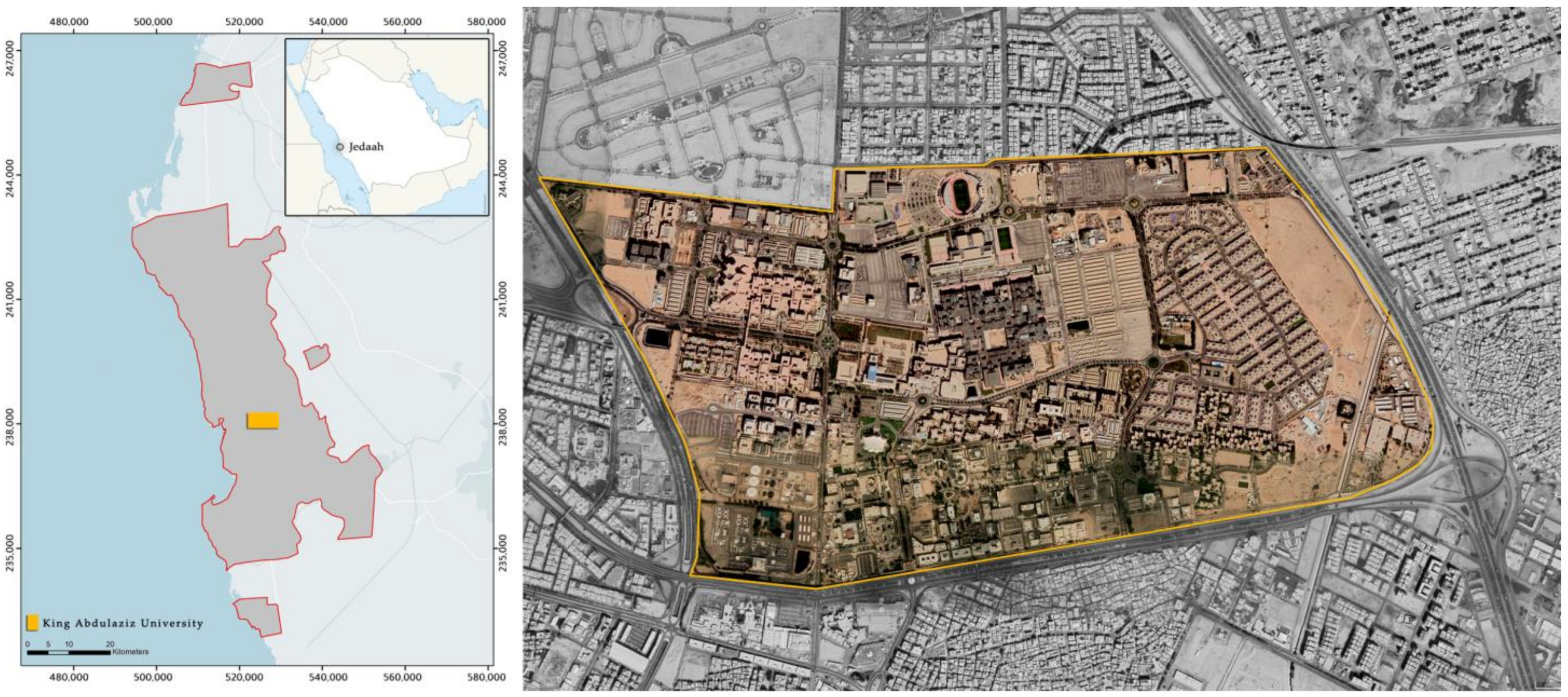
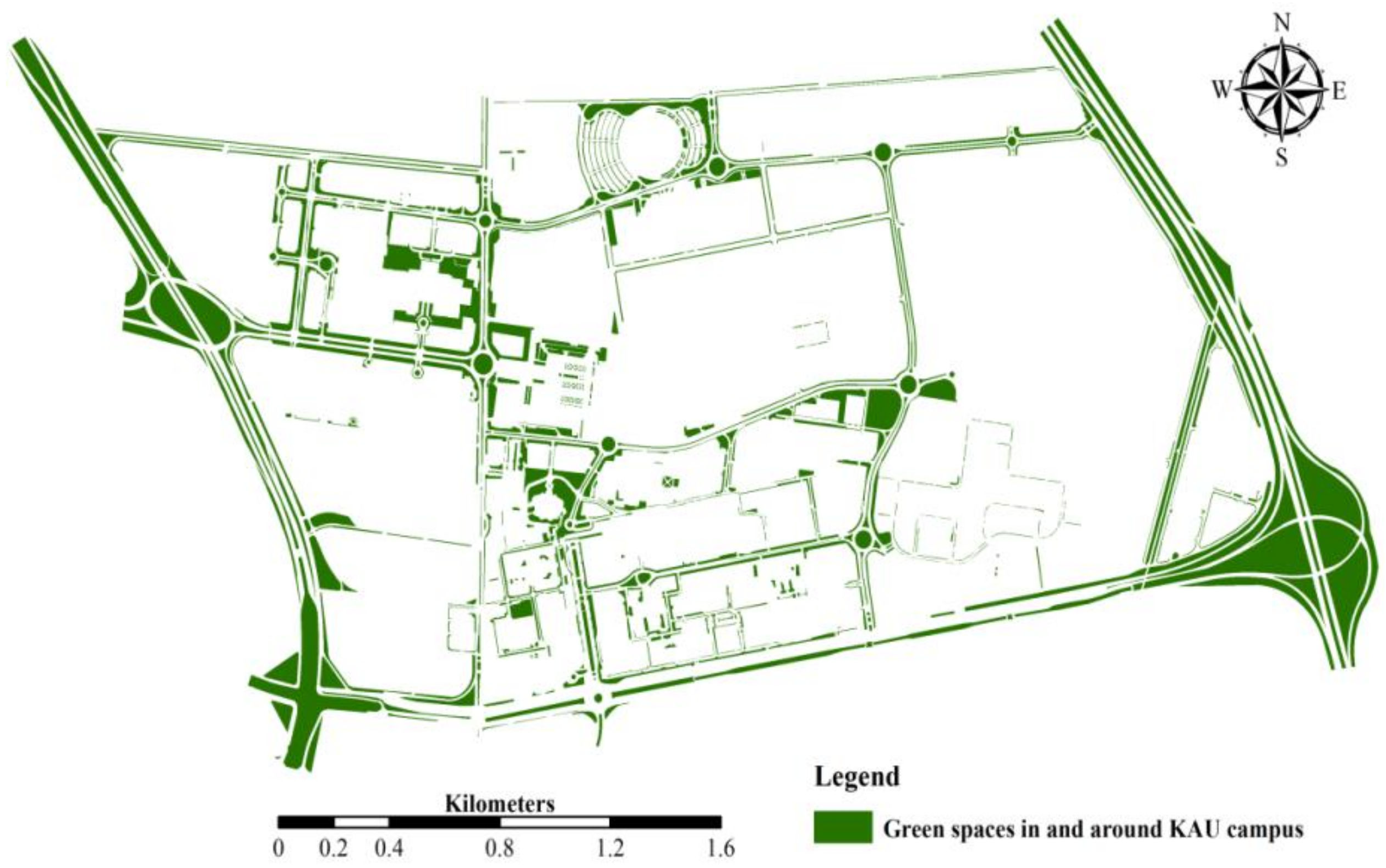
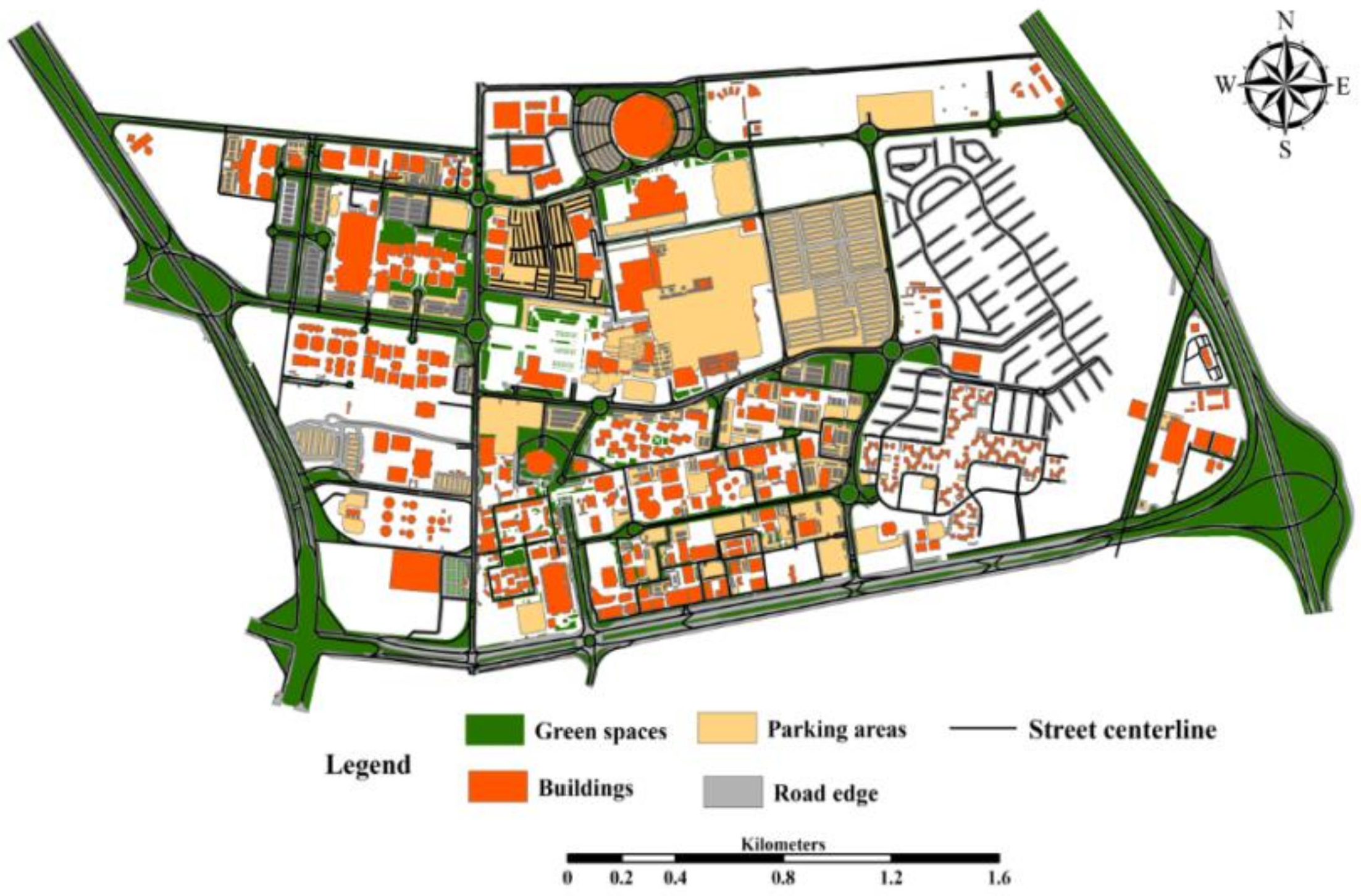
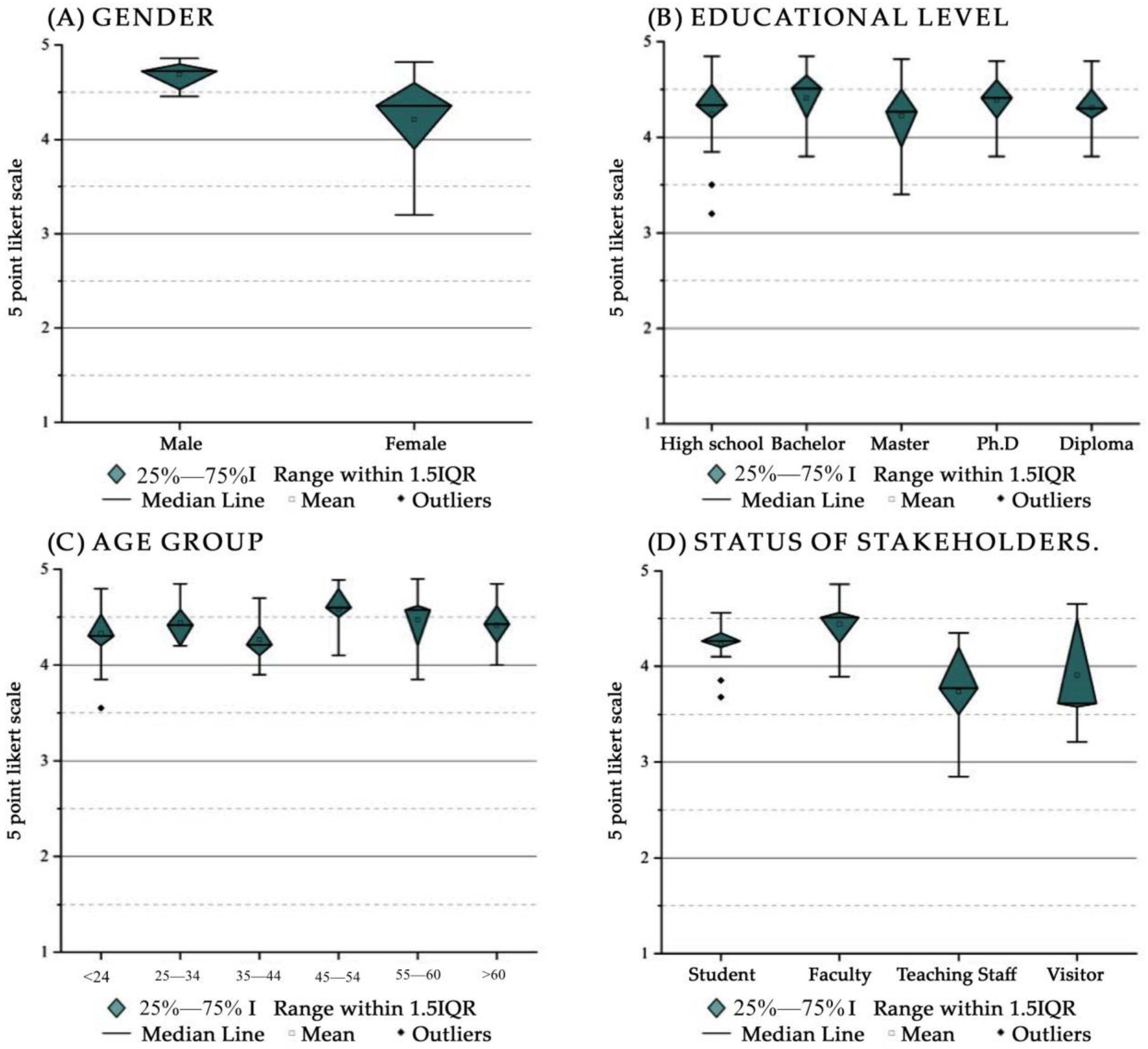
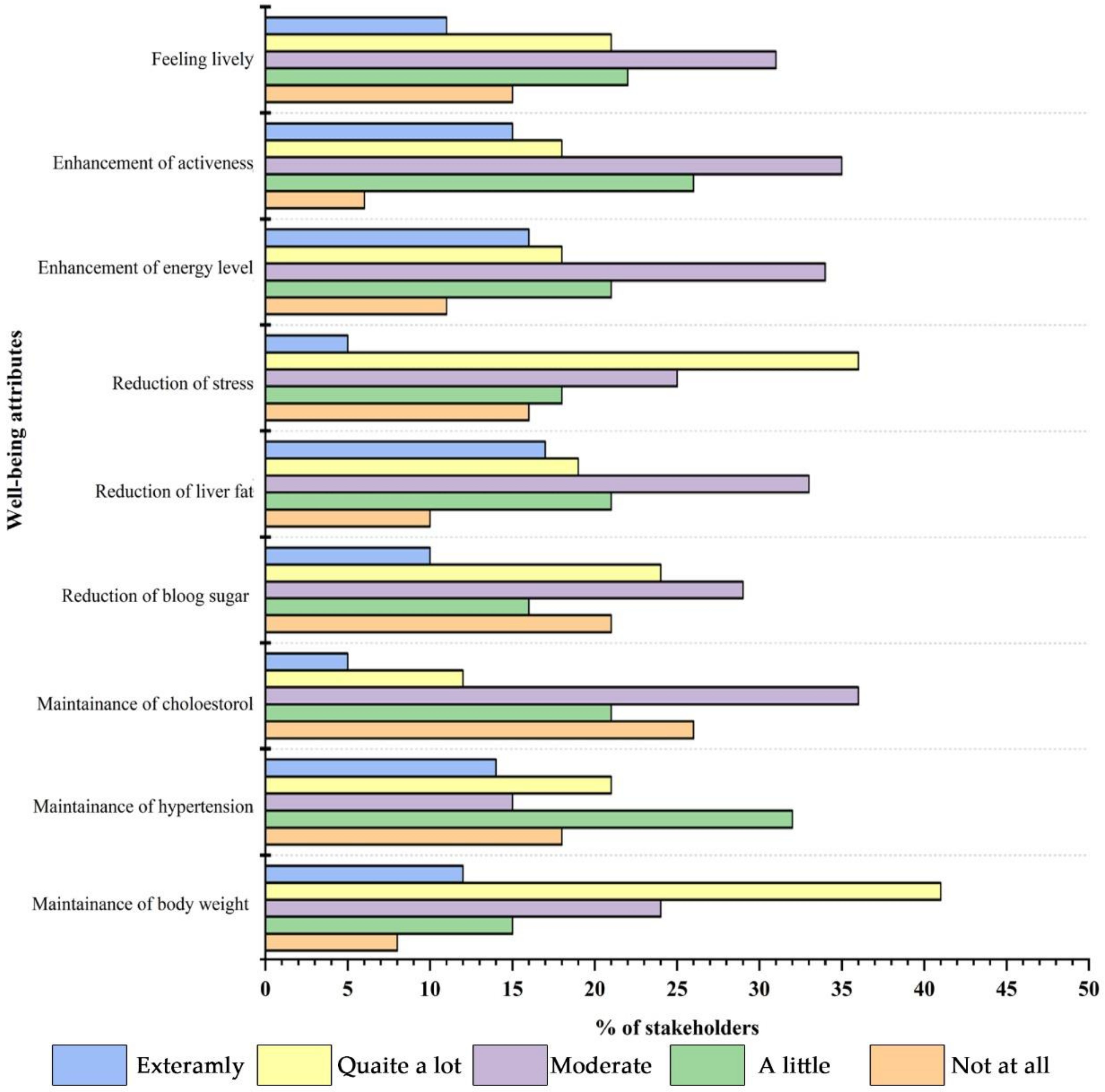

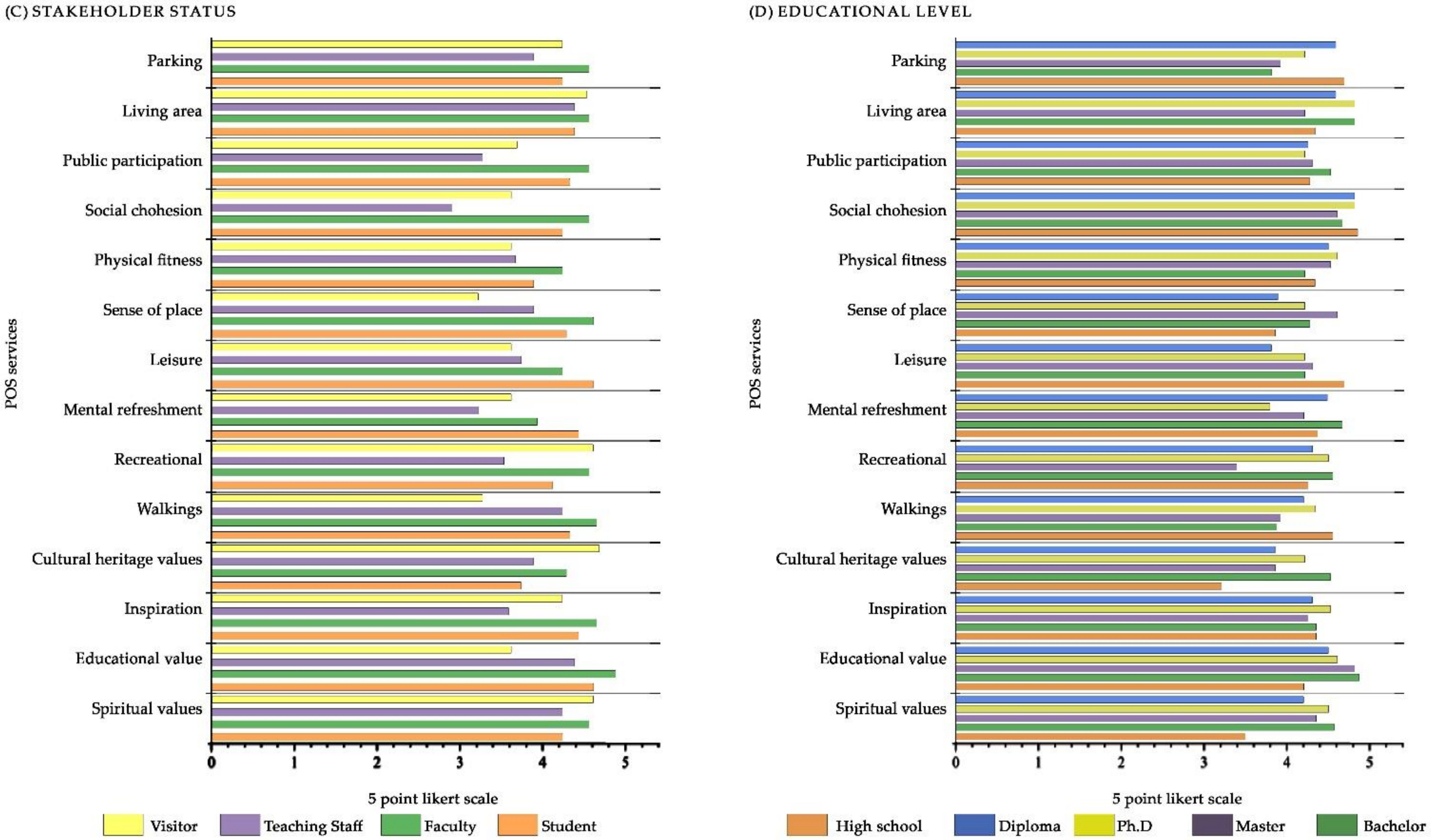
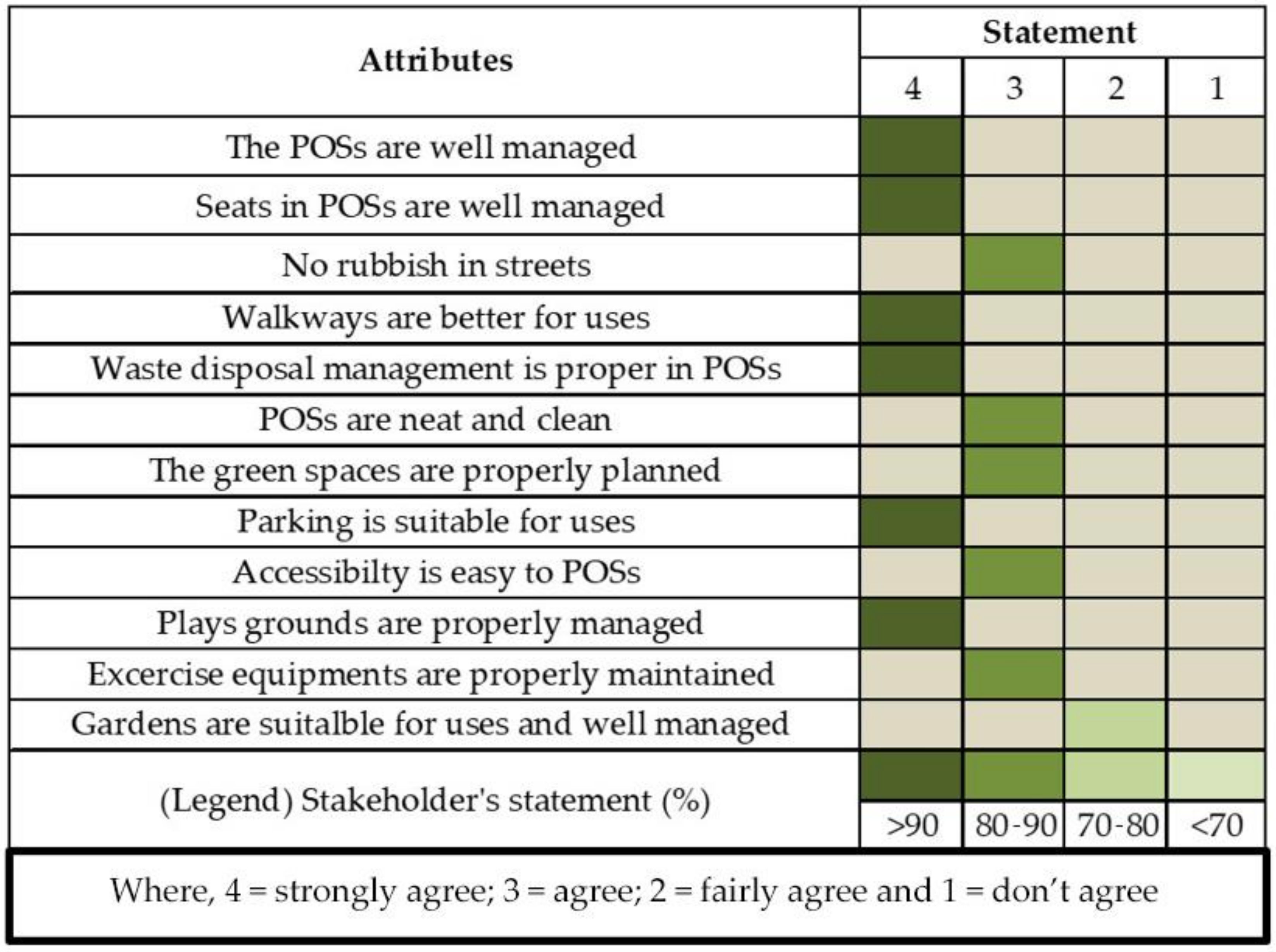


| Name of the University | King Abdulaziz University |
|---|---|
| Absolute location | Between 21°29′ N and 21°30′ N and 39°14′ E and 39°16′0″ E |
| Relative location | Eastern coast of the Red Sea |
| City | Jeddah |
| Establishment | 1967 |
| Total students | 82,152 |
| Total staff | 14,657 |
| Campus type | Male and female |
| Major buildings | Faculty buildings, university hospital, central library, administrative buildings, sports facilities, staff housing complex |
| SL No | Functions/Service of Public Open Spaces | Description |
|---|---|---|
| 1 | Spiritual values (SPv) | Many public historic and religious places (such as temples, mosques, and churches) have spiritual value. |
| 2 | Educational value (EDv) | As an institution, POS are very important. POS provide opportunities for study and group discussions. |
| 3 | Inspiration (Ins) | POS (such as gardens, parks, corridors) provide opportunities for inspiration related to work and study. |
| 4 | Cultural heritage values (CHv) | Many POS have their own cultural heritage and historical identity. |
| 5 | Walking (WLk) | POS (such as gardens and parks) are used for walking. |
| 6 | Recreational (REc) | POS used for recreation activities. |
| 7 | Mental refreshment (MRt) | Gardens and parks play a significant role in people’s mental refreshment. |
| 8 | Leisure (LEr) | POS used for leisure activities. |
| 9 | Sense of place (SPc) | People are closely attached to many POS for their functional value. |
| 10 | Physical fitness (PFs) | Walking and other physical activities enhance physical fitness. |
| 11 | Social cohesion (SCn) | Gathering people in POS enhances social relationships and cohesion. |
| 12 | Public participation (PPn) | POS provide various opportunities for formal participation. |
| 13 | Living area (LAa) | Many POS are suitable for living for their environment. |
| 14 | Parking (PRk) | People use POS for cars, motorcycles, and cycle parking. |
| POSS | Spiritual Values | Educational Value | Inspiration | Cultural Heritage Values | Walking | Recreational | Mental Refreshment | Leisure | Sense of Place | Physical Fitness | Social Cohesion | Public Participation | Living Area | Parking |
|---|---|---|---|---|---|---|---|---|---|---|---|---|---|---|
| Spiritual values | 1 | 0.313 | ||||||||||||
| Educational value | 0.313 | 1 | ||||||||||||
| Inspiration | 0.289 | 0.393 | 1 | |||||||||||
| Cultural heritage values | 0.685 ** | 0.011 | 0.201 | 1 | ||||||||||
| Walking | −0.375 | 0.420 | 0.053 | −0.241 | 1 | |||||||||
| Recreational | 0.005 | 0.003 | 0.429 | 0.384 | 0.266 | 1 | ||||||||
| Mental refreshment | 0.039 | 0.479 | 0.521 * | −0.005 | 0.252 | 0.336 | 1 | |||||||
| Leisure | −0.133 | 0.364 | 0.506 * | −0.067 | 0.432 | 0.121 | 0.476 | 1 | ||||||
| Sense of place | 0.261 | 0.684 ** | 0.338 | 0.371 | 0.489 * | 0.098 | 0.445 | 0.653 ** | 1 | |||||
| Physical fitness | −0.212 | 0.336 | 0.085 | −0.078 | 0.657 ** | 0.306 | 0.438 | 0.221 | 0.391 | 1 | ||||
| Social cohesion | −0.047 | 0.459 | 0.642 ** | 0.011 | 0.375 | 0.440 | 0.733 ** | 0.595 * | 0.516 * | 0.611 ** | 1 | |||
| Public participation | −0.002 | 0.504 * | 0.533 * | 0.106 | 0.560 * | 0.399 | 0.734 ** | 0.464 | 0.551 * | 0.737 ** | 0.724 ** | 1 | ||
| Living area | 0.137 | −0.058 | 0.154 | 0.522 * | 0.214 | 0.406 | 0.092 | 0.049 | 0.183 | 0.426 | 0.248 | 0.445 | 1 | |
| Parking | −0.125 | −0.019 | 0.323 | −0.101 | 0.555 * | 0.389 | 0.152 | 0.312 | 0.091 | 0.463 | 0.397 | 0.418 | 0.286 | 1 |
| Groups | Variables | Significant Level Tested | p-Value | Significant (Yes/No) |
|---|---|---|---|---|
| Gender | Male and female | 0.05 | 0.0278 | Yes (p < 0.5) |
| Status of respondents | Students vs. faculty members | 0.0718 | No (p < 0.5) | |
| Students vs. staff | 0.0032 | Yes (p < 0.5) | ||
| Students vs. visitors | 0.0491 | Yes (p < 0.5) | ||
| Faculty members vs. staff | 0.0003 | Yes (p < 0.5) | ||
| Faculty members vs. visitors | 0.0307 | Yes (p < 0.5) | ||
| Visitor vs. staff | 0.4650 | No (p < 0.5) | ||
| Educational status | High school vs. bachelor’s | 0.4777 | No (p < 0.5) | |
| High school vs. master’s | 0.5892 | No (p < 0.5) | ||
| High school vs. Ph.D | 0.8593 | No (p < 0.5) | ||
| High school vs. diploma | 0.9521 | No (p < 0.5) | ||
| Bachelor’s vs. master’s | 0.2380 | No (p < 0.5) | ||
| Bachelor’s vs. Ph.D | 0.6170 | No (p < 0.5) | ||
| Bachelor’s vs. diploma | 0.3734 | No (p < 0.5) | ||
| Master’s vs. Ph.D | 0.4413 | No (p < 0.5) | ||
| Master’s vs. diploma | 0.6599 | No (p < 0.5) | ||
| Ph.D vs. diploma | 0.6599 | No (p < 0.5) | ||
| Age | <24 vs. 25–34 | 0.5485 | No (p < 0.5) | |
| <24 vs. 35–44 | 0.1310 | No (p < 0.5) | ||
| <24 vs. 45–54 | 0.1260 | No (p < 0.5) | ||
| <24 vs. 55–60 | 0.4965 | No (p < 0.5) | ||
| <24 vs. >60 | 0.6455 | No (p < 0.5) | ||
| 25–34 vs. 35–44 | 0.0215 | Yes (p < 0.5) | ||
| 25–34 vs. 45–54 | 0.2891 | No (p < 0.5) | ||
| 25–34 vs. 55–60 | 0.8650 | No (p < 0.5) | ||
| 25–34 vs. >60 | 0.8807 | No (p < 0.5) | ||
| 35–44 vs. 45–54 | 0.0085 | Yes (p < 0.5) | ||
| 35–44 vs. 55–60 | 0.0480 | Yes (p < 0.5) | ||
| 35–44 vs. >60 | 0.0423 | Yes (p < 0.5) | ||
| 45–54 vs. 55–60 | 0.5892 | No (p < 0.5) | ||
| 45–54 vs. >60 | 0.2301 | No (p < 0.5) | ||
| 55–60 vs. >60 | 0.8181 | No (p < 0.5) |
| POSS | Component | |||
|---|---|---|---|---|
| 1 | 2 | 3 | 4 | |
| Spiritual values | −0.442 | 0.076 | 0.263 | 0.765 |
| Educational value | −0.033 | 0.297 | 0.858 | 0.038 |
| Cooling | −0.002 | 0.882 | 0.095 | 0.230 |
| Cultural heritage values | −0.015 | 0.039 | 0.035 | 0.950 |
| Walking | 0.735 | 0.003 | 0.471 | −0.257 |
| Swimming | 0.790 | 0.351 | −0.006 | −0.067 |
| Recreational | 0.520 | 0.466 | −0.292 | 0.382 |
| Mental refreshment | 0.266 | 0.733 | 0.308 | −0.058 |
| Improvement of air quality | 0.202 | 0.587 | 0.426 | −0.191 |
| Sense of place | 0.198 | 0.271 | 0.822 | 0.243 |
| Physical fitness | 0.805 | 0.083 | 0.369 | −0.026 |
| Social cohesion | 0.398 | 0.736 | 0.316 | 0.004 |
| Public participation | 0.622 | 0.509 | 0.416 | 0.128 |
| Living area | 0.604 | −0.034 | −0.042 | 0.625 |
| Parking | 0.625 | 0.260 | −0.084 | −0.045 |
| Variance explained (%) | 39.390 | 16.230 | 12.900 | 8.380 |
| Total services | 7 (46.66%) | 4 (26.66%) | 1 (6.66%) | 2 (13.33%) |
| Study Area | Author | Published Year | Objectives of the Study | Major Finding |
|---|---|---|---|---|
| Jeddah city (Saudi Arabia) | Addas and Rishbeth | 2018 | To examine the pattern of use, perceived benefits, and attachment related to POS. | Variations of POS use between social groups. |
| Riyadh, Dammam and Jeddah city (Saudi Arabia) | Addas and Maghrabi | 2020 | To measure availability and accessibility of POS across cities. | Discrepancies between desired level and actual availability of POS. |
| Jeddah city (Saudi Arabia) | Addas and Alserayhi | 2020 | To assess per-capita availability of POS. | Current status of POS fails to meet the international standard in the city. |
| Chittagong (Bangladesh) | Paul et al. | 2020 | To find the nexus between POS, green exercise, and well-being. | POS have an immense impact on physical as well as mental health. |
| Mandalay city (Mayanmar) | Wai et al. | 2018 | To understand the benefits of utilizing POS. | Utilization of POS was largely determined by the quality of POS. |
| Berlin (Germany) | Enssle and Kabisch | 2020 | To assess the role of urban green spaces for health, well-being, and social interaction for older people. | Older people were closely linked with good health and well-being. |
| Shanghai (China) | Shen et al. | 2017 | To measure inequalities in the accessibility to public green spaces (UGS). | Disparities in the accessibility to PGSs according to social and household status. |
| Shanghai (China) | Fan et al. | 2016 | To understand the accessibility to public urban green spaces (PUGS). | Spatial variations of accessibility to PUGS. |
Publisher’s Note: MDPI stays neutral with regard to jurisdictional claims in published maps and institutional affiliations. |
© 2021 by the authors. Licensee MDPI, Basel, Switzerland. This article is an open access article distributed under the terms and conditions of the Creative Commons Attribution (CC BY) license (https://creativecommons.org/licenses/by/4.0/).
Share and Cite
Addas, A.; Maghrabi, A. Social Evaluation of Public Open Space Services and Their Impact on Well-Being: A Micro-Scale Assessment from a Coastal University. Sustainability 2021, 13, 4372. https://doi.org/10.3390/su13084372
Addas A, Maghrabi A. Social Evaluation of Public Open Space Services and Their Impact on Well-Being: A Micro-Scale Assessment from a Coastal University. Sustainability. 2021; 13(8):4372. https://doi.org/10.3390/su13084372
Chicago/Turabian StyleAddas, Abdullah, and Ahmad Maghrabi. 2021. "Social Evaluation of Public Open Space Services and Their Impact on Well-Being: A Micro-Scale Assessment from a Coastal University" Sustainability 13, no. 8: 4372. https://doi.org/10.3390/su13084372
APA StyleAddas, A., & Maghrabi, A. (2021). Social Evaluation of Public Open Space Services and Their Impact on Well-Being: A Micro-Scale Assessment from a Coastal University. Sustainability, 13(8), 4372. https://doi.org/10.3390/su13084372







